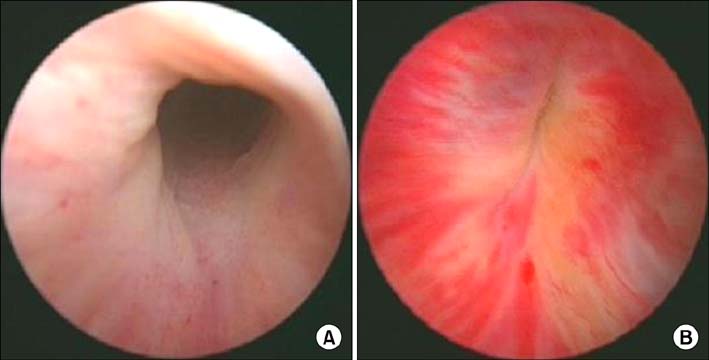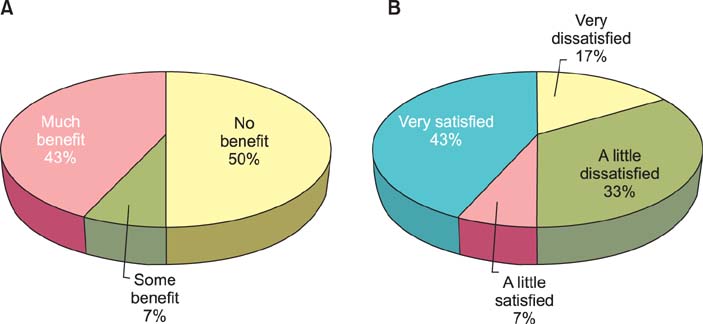Korean J Urol.
2014 Mar;55(3):182-189. 10.4111/kju.2014.55.3.182.
Treatment Outcomes of Transurethral Macroplastique Injection for Postprostatectomy Incontinence
- Affiliations
-
- 1Department of Urology, Samsung Medical Center, Sungkyunkwan University School of Medicine, Seoul, Korea. ksleedr@skku.edu
- 2Department of Urology, Samsung Changwon Hospital, Sungkyunkwan University School of Medicine,Changwon, Korea.
- KMID: 1988422
- DOI: http://doi.org/10.4111/kju.2014.55.3.182
Abstract
- PURPOSE
We investigated the efficacy of transurethral injection of Macroplastique bulking agent (Uroplasty) for male stress urinary incontinence (SUI) after prostate surgery.
MATERIALS AND METHODS
This retrospective review included men with SUI treated by transurethral injection for symptoms resulting from prostate surgery. Patients were evaluated at 1 month and 6 months after injection by determining the number of pads used per day and changes in incontinence symptoms. Treatment success was defined as use of 1 pad or fewer per day combined with subjective symptom improvement.
RESULTS
The study population comprised 30 men with a mean age of 66.1+/-5.3 years. Of the 30 patients, 24 (80.0%) underwent prostate cancer surgery and the remaining 6 (20.0%) underwent surgery for benign prostatic hyperplasia. The preinjection pad number was 2.9+/-1.9 pads per day. After injection treatment, the mean follow-up period was 9.3+/-12.7 months and the success rate was 43% (13/30) at 1 month and 32% (6/19) at 6 months. Injection was more likely to result in a successful outcome in patients with no preinjection radiation treatment history and higher abdominal leak point pressure (ALPP) than in those with a previous history of radiation treatment and lower ALPP, although this result was not statistically significant. Acute urinary retention occurred in 5 patients (17%).
CONCLUSIONS
Transurethral Macroplastique injection treatment is a relatively non-invasive treatment method for male SUI with a success rate of 43% at 1 month and 32% at 6 months. Patients with a higher ALPP and no previous history of radiation therapy may experience better treatment outcomes.
Keyword
MeSH Terms
Figure
Reference
-
1. Jung KW, Park S, Kong HJ, Won YJ, Lee JY, Seo HG, et al. Cancer statistics in Korea: incidence, mortality, survival, and prevalence in 2009. Cancer Res Treat. 2012; 44:11–24.2. Westney OL, Bevan-Thomas R, Palmer JL, Cespedes RD, McGuire EJ. Transurethral collagen injections for male intrinsic sphincter deficiency: the University of Texas-Houston experience. J Urol. 2005; 174:994–997.3. Sandvik H, Espuna M, Hunskaar S. Validity of the incontinence severity index: comparison with pad-weighing tests. Int Urogynecol J Pelvic Floor Dysfunct. 2006; 17:520–524.4. Pleil AM, Coyne KS, Reese PR, Jumadilova Z, Rovner ES, Kelleher CJ. The validation of patient-rated global assessments of treatment benefit, satisfaction, and willingness to continue--the BSW. Value Health. 2005; 8:Suppl 1. S25–S34.5. Catalona WJ, Carvalhal GF, Mager DE, Smith DS. Potency, continence and complication rates in 1,870 consecutive radical retropubic prostatectomies. J Urol. 1999; 162:433–438.6. Fowler FJ Jr, Barry MJ, Lu-Yao G, Roman A, Wasson J, Wennberg JE. Patient-reported complications and follow-up treatment after radical prostatectomy. The National Medicare Experience: 1988-1990 (updated June 1993). Urology. 1993; 42:622–629.7. Mebust WK, Holtgrewe HL, Cockett AT, Peters PC. Transurethral prostatectomy: immediate and postoperative complications: a cooperative study of 13 participating institutions evaluating 3,885 patients. J Urol. 1989; 141:243–247.8. Gousse AE, Madjar S, Lambert MM, Fishman IJ. Artificial urinary sphincter for post-radical prostatectomy urinary incontinence: long-term subjective results. J Urol. 2001; 166:1755–1758.9. Trigo Rocha F, Gomes CM, Mitre AI, Arap S, Srougi M. A prospective study evaluating the efficacy of the artificial sphincter AMS 800 for the treatment of postradical prostatectomy urinary incontinence and the correlation between preoperative urodynamic and surgical outcomes. Urology. 2008; 71:85–89.10. Cornel EB, Elzevier HW, Putter H. Can advance transobturator sling suspension cure male urinary postoperative stress incontinence? J Urol. 2010; 183:1459–1463.11. Hübner WA, Gallistl H, Rutkowski M, Huber ER. Adjustable bulbourethral male sling: experience after 101 cases of moderate-to-severe male stress urinary incontinence. BJU Int. 2011; 107:777–782.12. Elsergany R, Ghoniem GM. Collagen injection for intrinsic sphincteric deficiency in men: a reasonable option in selected patients. J Urol. 1998; 159:1504–1506.13. Malizia AA Jr, Reiman HM, Myers RP, Sande JR, Barham SS, Benson RC Jr, et al. Migration and granulomatous reaction after periurethral injection of polytef (Teflon). JAMA. 1984; 251:3277–3281.14. Stothers L, Goldenberg SL. Delayed hypersensitivity and systemic arthralgia following transurethral collagen injection for stress urinary incontinence. J Urol. 1998; 159:1507–1509.15. Santarosa RP, Blaivas JG. Periurethral injection of autologous fat for the treatment of sphincteric incontinence. J Urol. 1994; 151:607–611.16. Kylmälä T, Tainio H, Raitanen M, Tammela TL. Treatment of postoperative male urinary incontinence using transurethral macroplastique injections. J Endourol. 2003; 17:113–115.17. Cummings JM, Boullier JA, Parra RO. Transurethral collagen injections in the therapy of post-radical prostatectomy stress incontinence. J Urol. 1996; 155:1011–1013.18. Klutke JJ, Subir C, Andriole G, Klutke CG. Long-term results after antegrade collagen injection for stress urinary incontinence following radical retropubic prostatectomy. Urology. 1999; 53:974–977.19. Martins FE, Bennett CJ, Dunn M, Filho D, Keller T, Lieskovsky G. Adverse prognostic features of collagen injection therapy for urinary incontinence following radical retropubic prostatectomy. J Urol. 1997; 158:1745–1749.20. Colombo T, Augustin H, Breinl E, Schips L, Hubmer G. The use of polydimethylsiloxane in the treatment of incontinence after radical prostatectomy. Br J Urol. 1997; 80:923–926.21. Griebling TL, Kreder KJ Jr, Williams RD. Transurethral collagen injection for treatment of postprostatectomy urinary incontinence in men. Urology. 1997; 49:907–912.22. Faerber GJ, Richardson TD. Long-term results of transurethral collagen injection in men with intrinsic sphincter deficiency. J Endourol. 1997; 11:273–277.23. Smith DN, Appell RA, Rackley RR, Winters JC. Collagen injection therapy for post-prostatectomy incontinence. J Urol. 1998; 160:364–367.24. Tiguert R, Gheiler EL, Gudziak MR. Collagen injection in the management of post-radical prostatectomy intrinsic sphincteric deficiency. Neurourol Urodyn. 1999; 18:653–658.25. Schneider T, Sperling H, Rossi R, Schmidt S, Rubben H. Do early injections of bulking agents following radical prostatectomy improve early continence? World J Urol. 2005; 23:338–342.26. Imamoglu MA, Tuygun C, Bakirtas H, Yigitbasi O, Kiper A. The comparison of artificial urinary sphincter implantation and endourethral macroplastique injection for the treatment of post-prostatectomy incontinence. Eur Urol. 2005; 47:209–213.27. Onur R, Singla A. Comparison of bone-anchored male sling and collagen implant for the treatment of male incontinence. Int J Urol. 2006; 13:1207–1211.28. Costa P, Poinas G, Ben Naoum K, Bouzoubaa K, Wagner L, Soustelle L, et al. Long-term results of artificial urinary sphincter for women with type III stress urinary incontinence. Eur Urol. 2013; 63:753–758.29. Raj GV, Peterson AC, Webster GD. Outcomes following erosions of the artificial urinary sphincter. J Urol. 2006; 175:2186–2190.30. Kim SP, Sarmast Z, Daignault S, Faerber GJ, McGuire EJ, Latini JM. Long-term durability and functional outcomes among patients with artificial urinary sphincters: a 10-year retrospective review from the University of Michigan. J Urol. 2008; 179:1912–1916.
- Full Text Links
- Actions
-
Cited
- CITED
-
- Close
- Share
- Similar articles
-
- Intercavernous Embedding of Bulboperineal Urethra for Postprostatectomy Incontinence: Report of a Case
- Bladder Stone after Intraureteral Polydimethylsioxane (Macroplastique) Injection Therapy in Vesicoureteral Reflux Patient
- Sling Surgery for Male Urinary Incontinence Including Post Prostatectomy Incontinence: A Challenge to the Urologist
- Ureteral Submucosal Macroplastique Injection in the Treatmenet of vesicoureteral Reflux
- Transurethral approach to collagen injection in the female stress incontinence; Procedure of choice?



